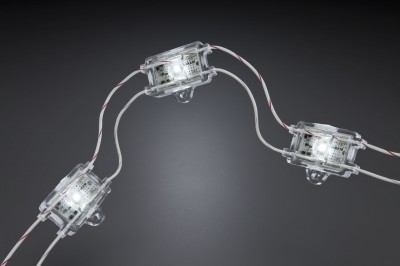Plug and play
Different jobs will entail different lighting requirements and pricing. Channel letters, especially, come in all imaginable sizes and depths, requiring a variety of versatile LED module types to illuminate them.
In some deep signs, for example, brighter LEDs are needed if they cannot be installed close enough to the face. Some of the appropriate modules offer a wider beam angle of up to 170 degrees to support even lighting in this type of configuration.

Low-profile, edge-lit LED panels allow illuminated signs to be placed nearly flush against wall surfaces.
Many ‘plug and play’ LEDs are very easy to install. They can be mounted along a profile track with predrilled holes, allowing them to be snapped right into place. The elongated track can be cut to the desired length—and given the predrilling, there is no need to measure the track, but instead simply count the right number of holes.
Another important advantage is protection against moisture. As durable solid-state products, LEDs are well-positioned to survive exposure to the elements.
Other forms
For the narrowest applications, edge-lit LED panels are available. At approximately 25 mm (1 in.) in depth, they are thinner than any fluorescent systems, allowing point-of-purchase (POP) displays, trade show graphics, menu boards and other signs to be installed in new places they could not before, nearly flush against wall surfaces. They are also more energy-efficient than fluorescent lighting and can last up to 2.5 times longer.
The low-profile panels can even be installed in jewellery cases and coolers in grocery stores, for example, where their lack of heat is advantageous over other forms of lighting. They use a ‘light guide’ to ensure uniform beam distribution across their dimensions, with no hot or dark spots.

When stringing ‘chains’ of high-brightness (HB) LED modules through a sign, the goal is to minimize the distance from the sign face and maximize the stroke spacing between the modules.
Many sizes Many sizes of LED panels are possible for different applications, snapping into corresponding front-load hatch frames. These single-faced versions are proving popular in many retail environments, but double-faced models have also been developed and should available soon.
Meanwhile, ‘border flex’ LED tubing is proving well-suited for many neon replacement applications, including weather-exposed architectural accents. These products are available in reels and can fit the curves and contours of stylized sign shapes, while providing vibrant colours—including red, blue, yellow, green, orange and white—to match the appearance of neon tubes.
Not all LEDs are created equal. A wide range of products are available to fit various pricing needs. In many cases, however, the best way for signmakers to save money is not to buy the least expensive systems, but instead to choose the right modules for the job and then use them in a thoughtful manner, using elements of sign design to optimize their performance.
Christopher Palmieri is LED lighting systems product marketing manager for Osram Sylvania. For more information, visit www.sylvania.com.





